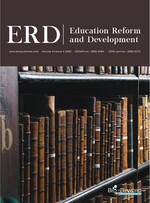Abstract
The rapid development of globalization is increasingly attaching significance to English usage and enlightenment worldwide. Following the law of language learning, more and more countries are making efforts to help their citizens become literate in English since early years. Picture books have played a crucial part in developing children’s emergent literacy skills. They provide children with fascinating illustrations, advancement in vocabularies, and meaningful sentence structures that go beyond the present contexts. However, picture book reading can be difficult for English as a Foreign Language (EFL) young learners due to the lack of English-speaking environment and language accumulation. With regard to this situation, this article analyzes and discusses the common debates on the print concept, phonological awareness, and vocabularies within an EFL early picture book reading setting to shed light on the practical direction in this field. Following this, this article coins relevant supporting strategies to ensure effective English picture book reading among children by developing supplementary activities, encouraging parent-child interaction, and applying multimedia materials. This article ends with a brief conclusion and questions that may need further exploration and research.
References
Auleear Owodally AM, 2015, Code-Related Aspects of Emergent Literacy: How Prepared Are Preschoolers for the Challenges of Literacy in an EFL Context?. Early Child Development and Care, 185(4): 509–527.
Kennedy A, 2006, Globalisation, Global English: ‘Futures Trading’ in Early Childhood Education. Early Years, 26(3): 295–306.
Liu M, Jackson J, 2008, An Exploration of Chinese EFL Learners’ Unwillingness to Communicate and Foreign Language Anxiety. The Modern Language Journal, 92(1): 71–86.
Shi Y, 2019, Kindergarten Teachers’ Perspectives on and Usage of Picture Books in EFL Classrooms in Shanghai, thesis, ProQuest Dissertations Publishing.
Hsiu-Chih S, 2008, The Value of English Picture Story Books. ELT Journal, 62(1): 47–55.
Larragueta M, Ceballos-Viro I, 2018, What Kind of Book? Selecting Picture Books for Vocabulary Acquisition. The Reading Teacher, 72(1): 81–87.
Shibata H, Omura K, 2020, Why Digital Displays Cannot Replace Paper, Springer Singapore Pte. Ltd., Singapore.
Chang C, Luo Y, Wu R, 2016, Origins of Print Concepts at Home: Print Referencing During Joint Book-Reading Interactions in Taiwanese Mothers and Children. Early Education and Development, 27(1): 54–73.
Dobbs-Oates J, Pentimonti JM, Justice LM, et al., 2015, Parent and Child Attitudinal Factors in a Model of Children’s Print-Concept Knowledge. Journal of Research in Reading, 38(1): 91–108.
Yopp HK, Yopp RH, 2000, Supporting Phonemic Awareness Development in the Classroom. The Reading Teacher, 54(2): 130–143.
Yang HC, 2009, Improving Phonological Awareness and Reading Through Rhyme Picture Books for EFL Elementary School Students, thesis, ProQuest Dissertations Publishing.
Elhassan Z, Crewther SG, Bavin EL, 2017, The Contribution of Phonological Awareness to Reading Fluency and Its Individual Sub-skills in Readers Aged 9- to 12-years. Frontiers in Psychology, 8: 533–533.
Nordlund M, 2016, EFL Textbooks for Young Learners: A Comparative Analysis of Vocabulary. Education Inquiry, 7(1): 27764.
Paivio A, 2008, Mental Representations: A Dual Coding Approach, Oxford University Press, Oxford, UK.
Sun C, 2017, The Value of Picture-Book Reading-Based Collaborative Output Activities for Vocabulary Retention. Language Teaching Research, 21(1): 96–117.
Min H, 2008, EFL Vocabulary Acquisition and Retention: Reading Plus Vocabulary Enhancement Activities and Narrow Reading. Language Learning, 58(1): 73–115.
Laufer B, Rozovski-Roitblat B, 2015, Retention of New Words: Quantity of Encounters, Quality of Task, and Degree of Knowledge. Language Teaching Research, 19: 687–711.
Chou M, 2014, Assessing English Vocabulary and Enhancing Young English as a Foreign Language (EFL) Learners’ Motivation Through Games, Songs, and Stories. Education, 42(3): 284–297.
McKay P, 2006, Assessing Young Language Learners, Cambridge University Press, Cambridge, UK.
Cheng K, Tsai C, 2016, The Interaction of Child-Parent Shared Reading with an Augmented Reality (AR) Picture Book and Parents’ Conceptions of AR Learning. British Journal of Educational Technology, 47(1): 203–222.
Vygotsky L, 1978, Mind in Society: The Development of Higher Psychological Processes, Harvard University Press, Cambridge, United States.
Farrant BM, Zubrick SR, 2012, Early Vocabulary Development: The Importance of Joint Attention and Parent-Child Book Reading. First Language, 32(3): 343–364.
Haggstrom M, 2020, The Art of Read-Aloud, Body Language and Identity Construction: A Multimodal Interactional Analysis of Interaction Between Parent, Child and Picturebook. International Journal of Language Studies, 14(1): 117.
Greenhoot AF, Beyer AM, Curtis J, 2014, More than Pretty Pictures? How Illustrations Affect Parent-Child Story Reading and Children’s Story Recall. Frontiers in Psychology, 5: 738–738.
Choi N, Kang S, Sheo J, 2020, Children’s Interest in Learning English Through Picture Books in an EFL Context: The Effects of Parent–Child Interaction and Digital Pen Use. Education Sciences, 10(2): 40.
Chen C, Tan C, Lo B, 2016, Facilitating English-Language Learners’ Oral Reading Fluency with Digital Pen Technology. Interactive Learning Environments, 24(1): 96–118.
Schugar HR, Smith CA, Schugar JT, 2013, Teaching with Interactive Picture E-Books in Grades K-6. The Reading Teacher, 66(8): 615–624.
